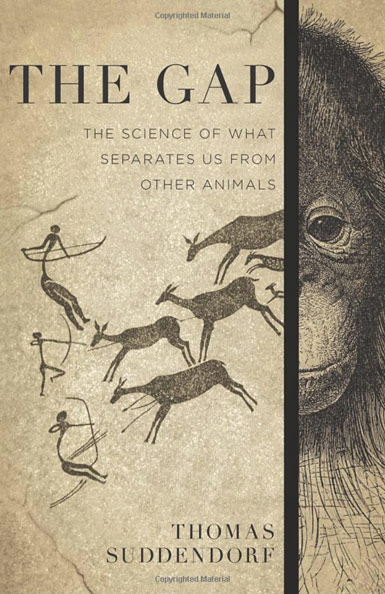Featured Book
The Gap
The Science of What Separates Us from Other Animals
Thomas Suddendorf
Hardcover edition 2013
Our drive to understand one another and our ability to imagine different possible futures is what makes us different from other animals. These two qualities transformed communication into language and empathy into morality. They enabled us to share plans and pursuits with individuals we are not related to, do not know, and have never seen.
The vast difference between human and animal minds is surprisingly difficult to define. It has been most often attributed to our superiority in one of six capacities: language, planning, social awareness, intelligence, culture, or morality.
Many people hold one of two opposing views of animal minds: romantics regard animals as “little people in furry suits,” while Killjoys see animals, and perhaps including humans, as programmed bio-machines. In The Gap, research psychologist Thomas Suddendorf concludes that our abilities in these areas far surpass those of animals because our minds evolved two overarching qualities: our drive to understand one another, and our ability to imagine different possible futures.
The Gap Is Much Smaller than We Think

Suddendorf proposes that the gap between human and animal minds would not appear so great had any of the archaic human species survived. Over the last six million years many more hominid species lived on the earth. 1.7 million years ago Homo erectus created the most successful tool ever invented by any hominid: the bifacial hand axe (which was around for well over a million years). During this time, erectus shared the planet with other hominins: australopithecines and with two species of paranthropus all of whom were tool-using, upright walking, big brained hominids. Even 40,000 years ago we were sharing the planet with Neanderthals, Denisovans, Homo floresiensis and possibly the last remnants of Homo erectus. So at that time the difference between humans and other animals would have been very small. The perceived gap therefore is so large now because other hominids have gone extinct.
Language
The role of these archaic hominids in the development of language and how language evolved from animal brains is a subject of research among current paleoanthropologists which will hopefully lead to a greater understanding.
Language is most often suggested as distinguishing the human mind from the animal. But some animals demonstrate a surprising ability to understand language. A border collie named Chaser can retrieve more than 1000 different objects on command and, when told to fetch an object whose name is unfamiliar to her, will bring back the thing that fails to match any of the objects whose names she knows. Dogs were the first domesticated animal, and the interest they show in understanding language evolved during their long association with humans. It stems from a combination of intelligence and social instincts that is reminiscent of the way young children learn.
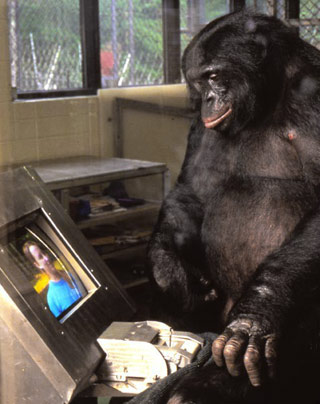
A few great apes have been taught hundreds of words of sign language and can use them to make requests and construct declarative sentences. They can even lie. The level of communication of these primates is about that of an average human two-year old. But these primates do not use tense, either future or past, or the subjunctive – “something might happen,” and so forth. The way these animals use language, and the way they learn it, demonstrates that the essence of our differences lies in our ability to think, to conjecture, and to imagine. The apes who have been taught to sign do not ask to learn new words, and they do not teach sign language to one another. Humans by contrast seem so hardwired to learn language that it is probably impossible for a healthy child in a normal environment not to do so. Newborns are more responsive to the human voice than to other sounds. By six months, infants are reproducing the sounds used in their native tongue. Before a year, they are pointing to objects to ask for their names. Language possibly evolved to facilitate the first of Suddendorf’s unique features of our minds – our urge to connect.
Language is constructed by combining relatively few symbols according to rules called syntax. It is well-suited to generating countless new ideas from just a few remembered events, facts, or concepts. This open-ended quality enables language to express the second unique human cognitive feature – imagination, or, as Suddendorf more accurately calls it, “recursion.”
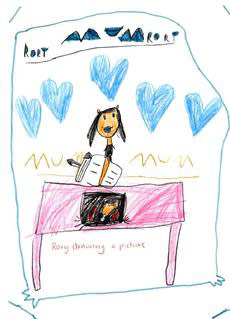
Recursion is seen most clearly when part of a sentence refers back to some preceding part of the sentence. But recursion enables us to do much more than just construct subordinate clauses. It can even indicate the mind that is creating the sentence – “I think, therefore I am.” A drawing by the 4 year-old daughter of a colleague of Suddendorf’s illustrates recursive thought. Rory is drawing herself making the drawing. Animals cannot display Rory’s level of self-awareness.
According to Noam Chomsky, recursion is the universal trait that defines human language, and is thought by some cognitive scientists to make possible music, art, and mathematics. A variety of intelligent species, including gorillas and dolphins, can recognize their reflections in a mirror, but does the creature reflect on the mind of the creature it sees? Our primate cousins never seem to indicate any interest in their own thoughts or in those of others.
“Time Travel”
When we say that we remember some event, we’re exercising episodic memory. This type of memory is notoriously unreliable. We recall the essence of some experience, and unwittingly fill in the details. Why did we ever evolve such an unreliable ability? Wouldn’t it be more adaptive to remember events more accurately? A clue to this puzzle is the discovery that people who have suffered brain damage causing them difficulty in remembering also have difficulty in imagining the future. Episodic memory appears to have evolved not to record the past but to plan for the future.
Imagining future possibilities may require this inexactness in our recollection. We rearrange our pliable memories to picture any number of different outcomes. In the words of Lewis Carroll, “It’s a poor sort of memory that only works backwards.” We even spend much of our waking hours living in an imaginary future. Suddendorf calls this “mental time travel,” and it underlies the second half of his thesis about what sets us apart from animals. For once we can imagine the future, then we can plan.
Episodic memory seems to be absent in animals, and this corresponds with their inability to make long-term plans. It is true that an ape may leave the sight of food to fetch a stick it can use to obtain it. However the time between these actions is never as long as an hour, usually much less. Chimps fed in the morning will throw away leftover food even though they will become hungry later in the day. Certainly some species save food for later scarcity, but this is an instinct, not reasoned out – squirrels born in spring will store food for a winter they have yet to experience.
Mind Reading
Language depends on an accurate guess about the mental state of another person. But we often do not need language to know what’s on someone’s mind. Simple gestures can reveal mental states, even unintentionally – a quick sideward glance may indicate disbelief about what someone is hearing. Psychologists call this the theory of mind – “theory” because we theorize about the mental states of others. The ability to understand what others are thinking is fundamental to human society. Do animals have this “mind reading” ability?
The unequivocal test of mind reading is “false-belief understanding.” Can you predict the actions of someone who is mistaken in his understanding of a situation? A child’s candy is hidden without her knowing it – where will another child who has witnessed this predict she will look for it? Children under the age of three say she will look for the candy where it has been hidden. Developing insight into the content of another’s mind takes practice. In numerous clever tests, nothing so far has indicated that any animal has false-belief understanding. An adult chimp will gesture for food from someone who is blindfolded.
Intelligence

There’s a tendency to believe animals think like us, a logical flaw called anthropomorphism. Clever Hans, a German horse, so impressed a panel of experts that they concluded Hans knew the days of the week, could perform arithmetic, and more. But careful testing revealed that Hans’ gift was the reading of body language of the questioners who unknowingly would provide clues when Hans’ hoof struck the right answer. Animals can perform at high levels in tests based entirely on their expectation of reward. Many animal behaviors that appear clever are actually instinctive and inflexible. Some birds will feed and care for the hatchling of another species snuck into their nests, even though the newcomer does not resemble them, and even after it kills their own offspring. It obviously doesn’t realize the difference so long as the nest is occupied.
A vital component of intelligence is short-term memory. It is essential for language, planning, and social functioning. The power of short-term memory, better called “working memory,” is due to its facility to combine and recombine data for evaluation. Humans can hold in mind about seven pieces of data – digits, words, even pictures, and so on. Seven pieces does not sound like many, but capacity can be greatly increased by “chunking,” that is, combining several pieces into a single new piece of data. Memory is then freed up to add more data. A simple example is combining the perceptions of time and of distance travelled into the notion of speed.
Chunking can continue up many levels to form abstract concepts. Relationships between concepts, for example how unemployment affects the economy, can then be examined. This recursive facility greatly increases the processing power of our minds. In contrast, the working memory of apes may be limited to only two or three chunks of data. More significantly, they do not appear to make associations between the data past a single level, say recognizing that two objects are the same color. While it is startling to witness an animal recognizing such patterns, it does not lead them to the open-ended combining that results in chunks of data becoming single abstract concepts.
Culture
Culture is the most important factor that allowed humans to dominate the Earth. With the right cultural knowledge we can live in the desert or in the Arctic. Culture can adapt to change much faster than our genes can adapt. We share plans and pursuits with individuals we are not related to, do not know, and have never seen. Such abstract cooperation is not found among animals. Culture is generationally transmitted even in the absence of written language by teaching and imitation.
Many animals of course teach their offspring how to hunt, to hide, and so on, but this is instinctive and inflexible. The motivation of great apes to teach other apes, even their own offspring, is limited at best. In one study, young children, capuchin monkeys, and chimpanzees were presented with a sequence of puzzles and rewards. The children taught each other, imitated each other, and shared the rewards. By contrast, the chimpanzees and monkeys earned the rewards only for themselves and showed no interest in teaching others.
Morality
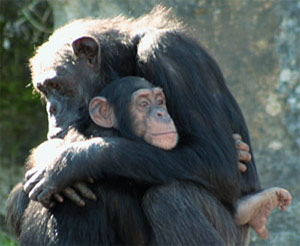
There are numerous examples of empathy among animals. Chimpanzees console others in distress. Even rats will forego rewards in order to rescue another rat in danger. Examples of social obedience abound as well – alpha primates are not shy about enforcing discipline. But morality requires more than empathy and obedience. Young children exhibit both selfish and generous behaviors, but we do not hold them responsible for their actions, nor do we judge animals in this way. Morality requires the ability to judge an action independently of its gain or loss for oneself.
Human societies judge what is fair, harmful, and cooperative almost universally in the same manner. These judgments seem to be instinctive, and no doubt evolved from our primate heritage. We call these instincts our conscience, and it determines much of our everyday behavior. Our drives to connect our minds and to imagine different futures transform our instincts into moral reasoning, which becomes codified into more-or-less rational, objective institutions. Darwin wrote that this moral development is “by far” the most important difference between humans and animals.
Concluding Topics
Whatever makes our minds different from the minds of other animals should not distract us from the many similarities. Our minds are wired in ancient ways. The gap is in a sense smaller then we might believe. We have two very powerful, unique qualities: our drive to understand one another and our ability to imagine different possible futures. These two qualities transform communication into language, empathy into morality, and so on. The well-known difficulties facing our species are largely of our own making, and a byproduct of our failure to understand the animal aspects of our minds. Suddendorf concludes that it is “only with a clearer understanding of where we come from and who we are can we gain a clearer view of where we are heading.”
About the Book’s Author: Thomas Suddendorf, Ph.D., is a Professor of Psychology at the University of Queensland in Australia and a fellow of the Association for Psychological Science. He has received awards from the Association for Psychological Science, the Academy of Social Sciences in Australia, the American Psychological Association and others. He has published more than 60 articles, The Gap: The Science of What Separates Us from Other Animals is his first book.
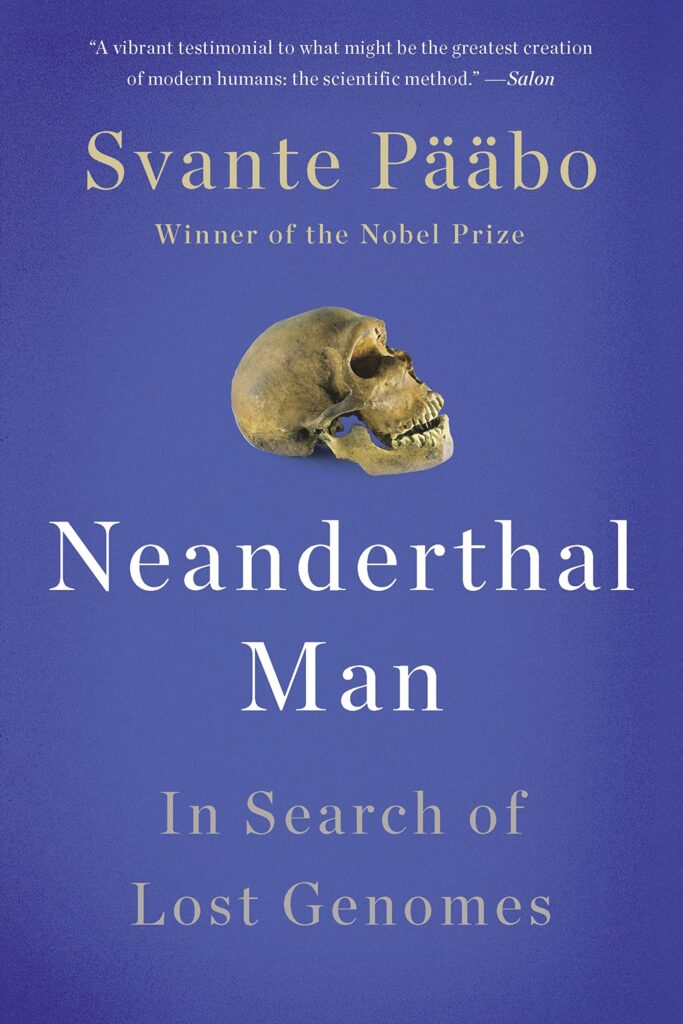
Neanderthal Man
In Search of Lost Genomes
By Svante Pääbo
Reviewed by George Kasabov
Neanderthals, our nearest cousin species, finally died out soon after 40,000 years ago. How are we related to them?

The Age of Empathy and The Bonobo and the Atheist
Frans de Waal
Both reciprocity and empathy – the two pillars upon which morality is built—are found in bonobos, apes and other social animals. But only humans are able to “abstract” the value and extend the behavioral constraints of “one-on-one” morality to the larger society, including strangers.
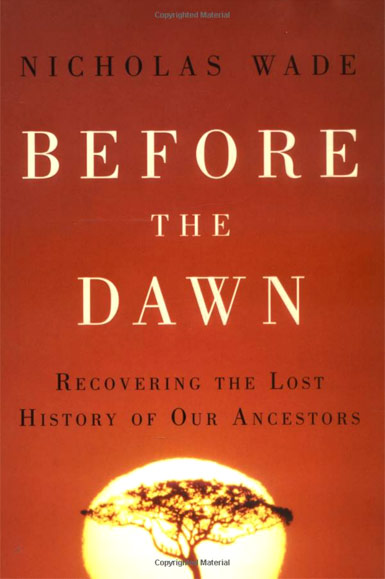
Before the Dawn
Recovering the Lost History of Our Ancestors
Nicholas Wade, New York Times
New York Times science writer explores humanity’s origins as revealed by the latest genetic science.
In the series: Our Prehistoric Ancestors
- Genetics and Human Evolution
- Our Nearest Relatives: Bonobos and Chimpanzees
- Our Hominid Predecessors
- She Has Her Mother’s Laugh
- Neanderthal Man – In Search of Lost Genomes
- The Evolution of Human Morality: The Age of Empathy and The Bonobo and the Atheist
- Before the Dawn: New details of human evolution revealed
Related articles:
Further Reading »
[get_bottomgrid_new_simple

